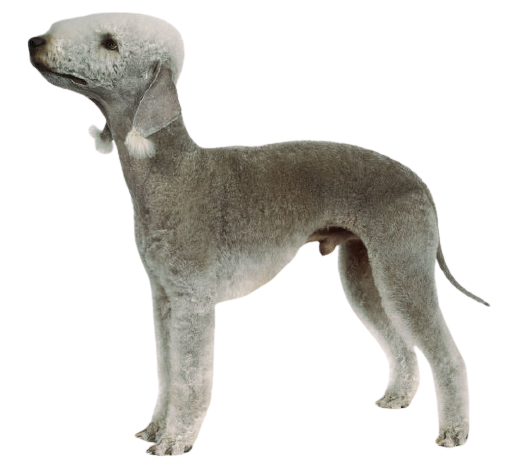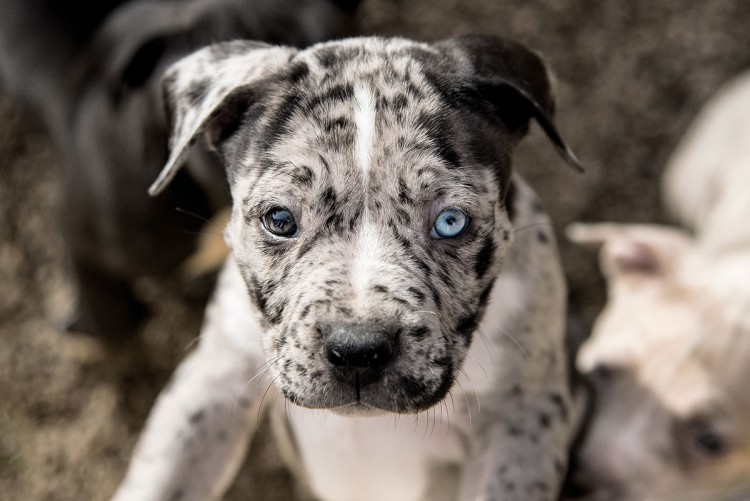
Bedlington Terrier
USD $1800-$2000 Price Avg.
Hunting Dogs
Group
Purebred
Breed Type
Medium
Size
14-16 years
Lifespan
Breed Information
| Group | Hunting Dogs |
|---|---|
| Popularity/Rank | 151 |
| Origin | United Kingdom |
| Other Names | Rodbery Terrier, Rothbury Terrier |
| Breed Type | Purebred |
| Price (Avg.) |
USD $1800-$2000
How much does it cost to purchase a Bedlington Terrier? The price of a Bedlington Terrier will vary from breeder to breeder as well as from place to place. As a rough guide, you should expect to pay between $1800 to $2000 per Bedlington Terrier if you purchase from a reputable breeder. Prices will be higher for show-quality dogs with a distinguished pedigree. Adult dogs who have already been trained may cost even more. It is usually less expensive to adopt a Bedlington Terrier through a shelter. |
| Size | Medium |
| Weight |
Male: 18-23 pounds (8-10 kg),
Female: 18-23 pounds (8-10 kg) |
| Height |
Male: 16-17 inches (41-43 cm),
Female: 15-16 inches (38-41 cm) |
| Lifespan | 14-16 years |
| Recognized by |
AKC, FCI
The American Kennel Club in 1886 as a Terrier breed. And FCI in the Terriers group, in the Large and medium sized Terriers section. |
| Purpose | hunting vermin |
| Date of Origin | 1800s |
| Ancestry | Terrier |
Appearance & Maintenance
| Coat | Curly |
|---|---|
| Coat Colors | Blue, Liver, Sandy, Tan |
| Grooming Level | |
| Shedding Level | |
| Eye Color Possibilities | Brown |
| Nose Color Possibilities | Black, Brown |
| Coat Color Possibilities | Blue, Brown, Sable |
| Coat Length | Medium |
| Coat Density | Dense |
| Coat Texture | Curly |
| Recommended Brushes | Clipper, Comb, Deshedder, Nail Clipper, Pin Brush, Scissors, Slicker Brush |
| Brushing Frequency | Daily |
Breed Characteristics
| Temperament | Affectionate, Caring, Dedicated, Devoted, Energetic, Intelligent, Loyal, Playful, Reliable, Sportive |
|---|---|
| Intelligent | |
| Trainability | |
| Playfulness | |
| Sensitivity Level | |
| Affection Level | |
| Social Interaction Required | |
| Barking | |
| Watchdog Ability | |
| Territorial | |
| Biting Force | Low |
| Mouthiness | |
| Impulse to Wander or Roam | |
| Prey Drive | |
| Adaptability | |
| Tolerates Being Left Alone | |
| Fighting Dog | Not really |
Good & Friendly with
| Apartment Life Friendly | |
|---|---|
| Stranger Friendly | |
| Kid-Friendly | |
| Cat Friendly | |
| Dog Friendly | |
| Office Friendly | No |
| Senior Citizens Friendly | |
| Pet Friendly | |
| Friendly with First Time Owners | Yes |
| Service Dog | Not really |
| Therapy Dog | Not really |
| Detection, Sniffer or Security Dog | Not really |
| Search and Rescue Dog (SAR) | Not really |
| Boat Dog | Not really |
| Cart Pulling or Drafting Dog | Not really |
Health Elements
| Health Issues | |
|---|---|
| Hypoallergenic | Yes |
| Energy Level | |
| Exercise Required | |
| Sleeping Required | |
| Weight Gain Potential | |
| Weather & Climate | Prefers average to cold weather conditions |
| Stinkiness | Medium |
| Drooling tendency | |
| Activity Level | Moderate |
| Rec. Walk Mileage Per Week | 6 miles |
| Minutes of Activity Per Day | 45 minutes |
Food & Costing
| Avg. Daily Food | Recommended daily amount: 1 to 1.5 cups of high-quality dry food a day, divided into two meals. |
|---|---|
| Cups Per Day | 2.5 cups |
| Daily Cost | $1.20 - $1.40 |
| Monthly Cost | $34.00 - $45.00 |
Reproducibility
| Gestation Duration | 60-64 days |
|---|---|
| How often can the Bedlington Terrier have a litter? | Once a year. |
| Litter Size | 3-6 puppies (Once a year.) |
Description
The Bedlington Terrier is a small, active, and intelligent breed of dog that has been around since the 19th century. They are known for their unique appearance, which includes a soft, curly coat and a distinctive head shape. They are also known for their friendly personalities and loyalty to their owners.
Appearance: The Bedlington Terrier has a unique look that sets them apart from other breeds. They have an oval-shaped head with small ears that stand erect on the sides of the head. Their eyes are almond-shaped and dark in color. The muzzle is short and pointed with a black nose at the end. The body is muscular with long legs and a deep chest. The coat is soft, curly, and can be either blue or sandy in color.
Lifespan: The average lifespan of the Bedlington Terrier is between 12 to 16 years when properly cared for.
Size & Weight: Bedlington Terriers typically weigh between 17 to 23 pounds when fully grown, making them one of the smaller breeds of dogs out there today. They usually stand between 14 to 16 inches tall at the shoulder when fully grown as well.
Colors: Bedlington Terriers come in two colors – blue or sandy – both of which have white markings on their faces, chests, bellies, legs, feet, tails tips as well as around their eyes and ears.
Personality: Bedlington Terriers are known for being friendly dogs who love spending time with their owners as well as other people they meet along the way! They’re also very loyal companions who will always be by your side no matter what you’re doing or where you’re going!
Friendliness: When it comes to friendliness towards other animals such as cats or other dogs they can get along just fine if introduced properly but may not always be overly friendly towards them due to their natural instinctive nature so it’s important to keep an eye on them if they’re around other animals just in case any issues arise! As far as children go they tend to do great with kids but should still be supervised while playing together just like any other breed would need too!
Temperament: Bedlingtons have an energetic temperament that makes them great companions for active families who enjoy outdoor activities such as hiking or running together! They also love playing games like fetch or tug-of-war which helps keep them mentally stimulated throughout the day!
Health: Generally speaking this breed tends to stay healthy throughout its life however there are some health issues that can arise such as eye problems (cataracts), skin allergies (atopy), liver disease (hepatitis) and kidney disease (renal dysplasia). It’s important to make sure your pup gets regular checkups from your vet so any potential health issues can be caught early on before they become more serious problems down the road!
Adaptability Level & Benefits As Pets : This breed does best in homes where someone is home most of the time since they do require quite a bit of attention from their owners but if you work full time then having another pet companion could help keep your pup entertained while you’re away during those hours! In terms of adaptability level this breed does fairly well when it comes adjusting into new environments however it may take some time before they feel completely comfortable so patience will definitely be needed here too! As far benefits go these pups make wonderful family pets due to how loving and loyal they are plus since they don't shed much at all this makes them ideal for those who suffer from allergies too!.
History
The Bedlington Terrier is a small, elegant dog breed with a distinctive lamb-like appearance. The breed originated in the town of Bedlington, England in the early 19th century. The Bedlington Terrier was originally bred as a hunting dog, but eventually became popular as a companion dog and show dog. The breed nearly became extinct in the early 20th century, but was saved by a few dedicated breeders. Today, the Bedlington Terrier is recognized as a distinct breed by major kennel clubs around the world.
The Bedlington Terrier's ancestry is somewhat unclear. Some believe that the breed is descended from the Whippet, while others believe that it is descended from the Otterhound. However, it is certain that the Bedlington Terrier shares ancestry with both of these breeds. The first recorded mention of the Bedlington Terrier was in 1825, when an Englishman named John Russell wrote about a type of terrier that was popular in his hometown of Bedlington.
In 1877, the first official standard for the Bedlington Terrier was published by the Kennel Club of England. The standard described a small, compact dog with a lamb-like appearance and a blue-grey coat. TheBedlington Terrier quickly gained popularity as a companion dog and show dog in England and Europe. However, the breed nearly became extinct during World War I due to food shortages and lack of interest from breeders.
A few dedicated breeders kept the Bedlington Terrier alive during this time, and eventually helped to re-establish the breed after the war. Today, the Bedlington Terrier is once again a popular companion dog and show dog around the world.
Bedlington Terrier Posts
Explore Bedlington Terrier's photos, videos, activities, stories, and facts.




